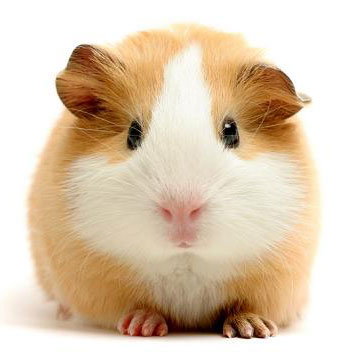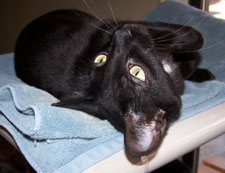
NOVEMBER 2, 2011
Guinea Pigs
 You see them frequently in the pet store: interesting, oblong-shaped creatures, generally larger than the other rodents they are grouped with. Housed in the same location as smaller rodents, many people think that their care is similar to that of a hamster or rat. However, guinea pigs have their own special requirements that differ vastly from those of the other small animals around them.
You see them frequently in the pet store: interesting, oblong-shaped creatures, generally larger than the other rodents they are grouped with. Housed in the same location as smaller rodents, many people think that their care is similar to that of a hamster or rat. However, guinea pigs have their own special requirements that differ vastly from those of the other small animals around them.
Guinea pigs, or cavies, are not actually related to pigs, nor are they from Guinea. According to Dr. J. Jill Heatley, associate professor at the Texas A&M College of Veterinary Medicine & Biomedical Sciences, they are actually native to South America.
“Guinea pigs were domesticated by the ancient South American people as a source of food,” states Heatley. “The ‘pig’ part in their name likely refers to their appearance, as they have shorter legs and large heads.”
Generally docile and inquisitive, guinea pigs can make great pets. Most seem to enjoy human interaction. They are usually fairly quiet, but if they hear the sound of their food being prepared, they can respond with shrill squeaks and boisterous leaps around their cage.
“There is quite a range of sounds in a guinea pig’s vocabulary,” says Heatley. “’Wheeking’ is a vocalization that is generally heard when a guinea pig thinks it is about to receive food. It may have heard the refrigerator door open and close, and this is its way of begging you to bring its food quickly. A ‘rumble’ is a purring sound that usually happens when a male is courting a female. Purring can also happen if your guinea pig is enjoying being stroked. A quick, short purr, followed by the guinea pig going still, means that it just heard a noise that it is afraid of. A ‘shriek’ is a very high-pitched wheek that usually is a call of alarm or a cry of pain or fear. If a guinea pig chatters its teeth, it is very angry. This is a warning to other guinea pigs or humans that the guinea pig wants to be left alone.”
Guinea pigs can weigh up to two and a half pounds and can reach a length of under a foot. Their size makes them easier to handle than other smaller rodents. Their average life span is four to eight years, so acquiring a new pig should not be done on impulse.
“As they are social animals, guinea pigs enjoy having at least one companion,” says Heatley. “A guinea pig living by itself will be lonely and can become depressed. Therefore, it is a good idea to have a large cage that can house two compatible guinea pigs together.”
Female pairs and male/female pairs work well, although males need to be neutered before being housed with females to prevent babies. Two males can also be cage mates, but extra caution needs to be taken when introducing them. Guinea pigs occasionally like to have some alone time, so they will appreciate the largest size cage you can manage. A minimum size of seven and a half square feet is recommended for up to two guinea pigs.
“A healthy diet is instrumental in maintaining your guinea pig’s health,” asserts Heatley. “They require a mixture of fruits and vegetables, along with a high quality pellet. They should also have continual access to hay. Additionally, guinea pigs cannot manufacture vitamin C, and store-bought pellets will not supply an adequate amount to meet their needs. This is because vitamin C is very heat sensitive and will rapidly degrade in less than a month of shelf storage at a controlled room temperature. Therefore, sufficient supplementation is required.”
This can be achieved by feeding your pigs fruits and vegetables that are high in vitamin C, such as parsley, bell peppers (remove seeds first), kale, kiwi, and strawberries. Feed fruit sparingly, as it is high in sugar and can cause obesity if fed too frequently. Offering a mixture of three to five different vegetables per day gives your guinea pigs a good variety. Always introduce new foods gradually, as sudden changes in diet can lead to gastrointestinal upset.
Another consideration for guinea pigs is the fact that their teeth are continually growing. To help keep their teeth filed down, a wood chew should be provided. These can be purchased at pet stores; anything brought in from outdoors should be disinfected first to avoid introducing parasites to the guinea pig’s environment. Additionally, the guinea pig’s toenails will need to be clipped monthly. This can be done using small, scissors-style clippers. Be careful to not cut into the quick, or living part of the nail, which will cause bleeding. You can also use this time to check your guinea pig’s feet for sores and ingrown toenails, as these are common problems.
“Seldom do guinea pigs need baths,” states Heatley. “They do shed, however, so daily brushing with a soft brush can help to remove loose hair and reduce shedding. Brushing is especially important for long-haired guinea pigs to keep the hair from tangling. If your guinea pig does require a bath, make sure to use a shampoo made especially for small animals.”
Be sure to use a shallow bowl of warm water when bathing your guinea pig. Rinse the guinea pig thoroughly, but avoid getting water in its ears. Also, make sure to dry its body meticulously before putting it into its cage to avoid chills.
Finally, guinea pigs benefit from some exercise around the house. Only place them on the floor if they will be monitored, and make sure to adequately block any downward stairs. Guinea pigs do not understand heights, so do not set them unsupervised on a table or ledge. Always hold them securely so that they cannot wiggle out of your arms.
Guinea pigs make fun companions. Each has a unique personality, from the loud male that is constantly on the alert for food to the female that runs up to the front of her cage when her owner walks into the room. If you do your research and provide your guinea pigs with the proper care and space, they can make wonderful additions to your family.
Pet Talk is a service of the College of Veterinary Medicine & Biomedical Sciences, Texas A&M University.



